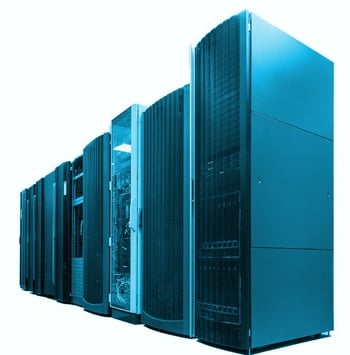
Thanks for returning for Part Seven of Tech Service Today's technical buyer's guide series called Size Matters - Especially When Choosing A Network Rack. This series explains why IT professionals must evaluate every dimension of a cabinet or rack before purchasing one. When a rack or cabinet is chosen based on only one or two dimensions, the result is a cabinet that does not properly accommodate your equipment. To avoid the costly mistake of purchasing the wrong rack, just follow the advice offered in this series.
In our first six segments, we explained the importance of each of these rack measurements and provided tips for calculating your size requirements for each:
Internal Depth and Maximum Rail Depth
In today's segment, we discuss the various types of doors available for most rack-mount enclosures so IT professionals recognize which type will best meet their needs. While types of rack doors are not exactly a measurement (as all previous segments of this series have been), it is an important option requiring serious consideration when choosing a new cabinet.
Part 7 - Door Types for Rackmount Enclosures
There are three basic types of doors that most rack-mount enclosure manufacturers offer: Steel (solid and vented), Glass (tempered or Plexi), and Mesh. While still the perfect solution to house lots of patch panels and other passive equipment used in large networks, cabinets with Steel Doors are far less common than those with Glass or Mesh doors because they do not provide adequate ventilation (making them a poor choice for storing sensitive electronics), and they prevent the visual monitoring of the equipment inside (unless a door is opened).
Cabinets with glass front doors are the most visually appealing option because they offer clear visibility into all the equipment mounted inside. When placed in high-profile areas where there is lots of foot traffic, cabinets with glass doors enable companies to showcase their technology in the most aesthetically pleasing way. But there is a down-side to enclosures with glass front doors.
Whether glass or steel, any solid front door on a cabinet severely restricts air flow. Ignoring this can be a costly mistake when the cabinet will contain servers and other sensitive network electronics. While there do exist fans and blowers that, when laid out strategically, can provide the air-flow and cooling needed to prevent equipment from overheating, they rely on empty spaces being left above many of those devices. So when planning a high-density solution wherein electronics and servers will occupy every U of space on your rails, the best choice is a cabinet with a Mesh front door.
While my definition of a steel Mesh door is clear and specific, be forewarned that some rack and cabinet manufacturers use the term mesh loosely to mean any door through which a lot of air can flow. This includes doors that I would describe as perforated steel doors, which are merely a steel door through which hundred of holes have been punched. So make sure you know exactly what you are getting when ordering a cabinet. This means doing more than looking at a picture of a cabinet because those photos often represent the base model of a customizable product line. So if you custom configure an enclosure, make sure you review all the specifications to confirm that what you see is a true representation of what you get.
While we addressed limited space concerns in the previous segments of this series addressing external dimensions of cabinets, it is important to consider any space limitations when choosing doors for your cabinet. When a cabinet will be in a large, open environment, then there is ample room to swing the front and rear doors open with obstructions. But full-size front doors can present problems in small spaces.
If your cabinet will be placed in a telecom closet with limited space or in a small data center where it will be situated relatively close to a wall, then look for a cabinet with split-rear doors. Because split rear doors are only half the width of a full-size door, you need far less space to open them. For extremely tight environments, you may want to consider a cabinet with a split front door too.
In addition to single, full-size doors, and split, half-width doors, a third flavor of doors exists in which several short, full-width doors appear on one face of a cabinet. This gives the illusion that several small rack-mount enclosures have been stacked on top of one another.
These multi-door enclosures - or co-location cabinets, as they are branded by several rack manufacturers - typically have two, three, sometimes even four separate doors on both the front and back. Each door provides access to a single compartment within the cabinet. Since each compartment prevents access to adjacent ones above and below it, co-location cabinets are the perfect solution for multi-tenant buildings wherein each tenant's network equipment is housed in a shared space, inside a secure portion of a shared cabinet.
As you should now understand, there are far more types and sizes of doors for rack-mount enclosures than most IT professionals realize. It is our hope that this segment enables you to be a more discerning, knowledgeable buyer the next time you are in the market for a new network equipment or server cabinet.
Tech Tip #7 - Choosing Cabinet Doors
Here are today's tips for determining the which doors to choose on your next cabinet.
- If your cabinet will house lots of servers and other sensitive network electronics, always choose a cabinet with mesh front and rear doors.
- If your cabinet will be used primarily for passive equipment like patch panels and switches, choose whichever doors you find to be the most aesthetically pleasing.
- If your cabinet will be placed in a tight space (i.e. a closet, IDF, or store manager's office), choose one with split-rear doors (and split front doors if necessary) to reduce the amount of room needed to open the doors and access your equipment.
Be sure to come back next week for segments eight and nine of our Size Matters series, when we will talk about What's Included (or Not Included) with your new Rack-Mount Enclosure, and all of the fundamental Rack-Mount Accessories that ensure a new cabinet will look just the way you imagined it, and not like one of the IT Disasters we feature on our blog page every Friday.
Are you planning an IT rollout project involving the installation of new hardware and/or racks to multiple sites? Then download a free copy of TST's Best Practices for IT Rollout Projects.
5
Need help installing, troubleshooting, testing, documenting, or replacing your network cabling? Contact Tech Service Today for on-site technical services anywhere in North America - often in 4-hours or less.
Or call (800) 973-2022 (option 1)


